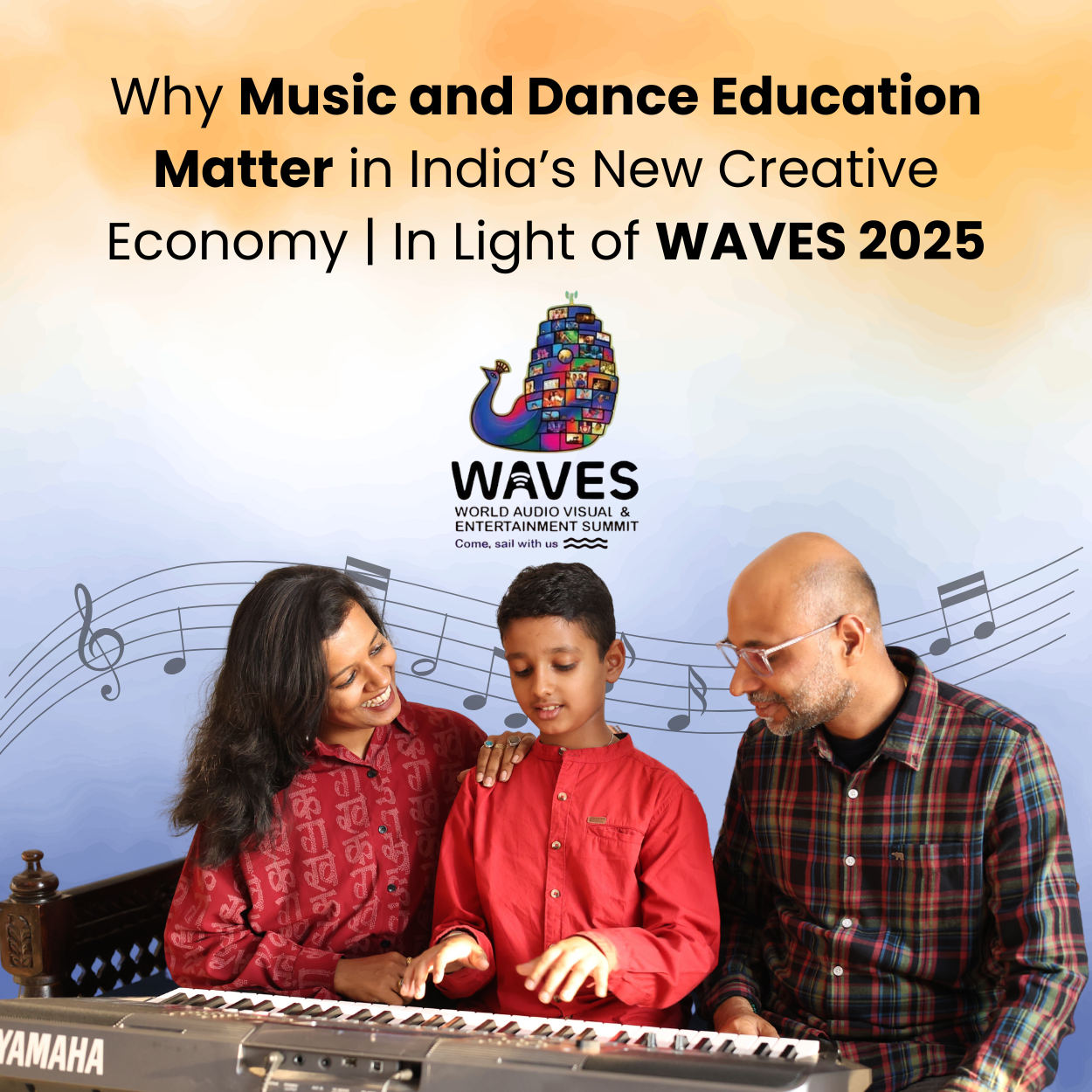
Table of Contents
WAVES, 2025 - Summit
At the recent WAVES 2025 Summit—a landmark global forum on India’s creative economy, a powerful message emerged: India’s next wave of growth will be led not just by code and infrastructure, but by creativity, culture, and human expression.
“India’s creative economy is a major pillar of our future GDP.” — Prime Minister Narendra Modi
Held in Mumbai, the summit brought together influential voices including Adam Mosseri (CEO, Instagram), Shantanu Narayen (CEO, Adobe), Ted Sarandos (Co-CEO, Netflix), and Nita Ambani, all of whom emphasized the critical role of design, storytelling, music, and the performing arts in building a future-ready India.
This shift isn’t theoretical—it has real implications for parents, educators, and learners everywhere—especially those engaged in music and dance.
Here’s what WAVES 2025 signals—and what it means for you.
1. Creative Education is Economic Preparation
The idea that music and dance are just hobbies is outdated. As highlighted at WAVES 2025, the creative economy is growing fast—and contributing billions to India’s GDP.
“India’s growth will shift from code to creativity.” — Shantanu Narayen, CEO, Adobe
In today’s world, learning a classical art form isn't just cultural—it’s strategic.
It cultivates focus, creativity, and emotional intelligence. These are the same qualities driving demand in design, storytelling, media, and digital content.
2. Music and Dance are Career Catalysts
WAVES 2025 spotlighted India’s growing creator economy.
Instagram Reels and YouTube Shorts remain India’s top-performing formats, largely driven by music, dance, and expressive content.
Spardha offers more than training—it provides platforms for visibility, whether it’s an Open mic, a global music competition like Spardha Global Idol, first-ever music competition specially for school students - Spardha School Idol or radio collaboration through a strategic partnership with Radio Mirchi.
In a world where performance is often the gateway to opportunity, these experiences matter. Because when students perform, they’re not just sharing a song or routine—they’re building identity, resilience, and confidence.
3. 🌍 For NRI Families, This is a Cultural Anchor
At WAVES 2025, Prime Minister Modi underscored the importance of India’s culture being not just preserved—but projected globally:
“Create in India, Create for the World.” — PM Narendra Modi
And as Nita Ambani reminded us during the summit:
“Performing arts like music and dance are carriers of ancient intelligence.” — Nita Ambani
For many NRI families, this isn’t a metaphor—it’s a lived truth. In homes where children grow up balancing two or more cultures, Indian classical music and dance offer something deeply grounding. They’re not just lessons—they’re a way to stay connected to who you are, while building the confidence to express it anywhere in the world.
🎓 At Spardha, we help bridge that gap—offering flexible, high-quality online training in Bharatanatyam, Kathak, Carnatic and Hindustani music, and more, all designed to fit into modern, global family life.
Because what your child learns today isn’t just culture—it’s a lifelong source of identity and strength.
4. AI Can Replicate Tasks—Not Expression
One of the most important discussions at WAVES 2025 focused on the rise of AI—and the increasing value of human-first skills.
“The goal is not to create robots, but emotionally rich individuals.” — PM Modi
Performing arts build precisely what machines can’t: presence, sensitivity, and emotional depth. These aren’t soft skills—they’re survival skills in an automated world.
“AI doesn’t replace the artist—it accelerates imagination.” — Richard Kerris, NVIDIA
🎵 Music and dance train students to connect, express, adapt—and lead.
5. Self-Expression Is a Tool for Mental Strength
Today’s children and teens face constant digital noise, performance pressure, and emotional overload. One of the quiet truths shared at WAVES 2025 was this: creative expression helps them cope, heal, and thrive.
“We must nurture the human spirit in a digital era.” — Nita Ambani
At Spardha, we see this every day. For some, it’s the joy of singing a scale. For others, it’s the confidence to perform on video. But in every case, the act of expression becomes a form of emotional literacy.
🧠 And that’s what builds long-term confidence—not just as artists, but as people.
6. Indian Classical Arts Are Global Assets
Indian art forms are not relics—they’re gaining global recognition and demand.
“India is on the brink of global creative leadership.” — Ted Sarandos, Netflix
When students learn classical music or dance, they’re engaging with centuries of knowledge, refined through practice—and now welcomed on global stages.
🌍 Spardha’s curriculum blends tradition with digital reach, allowing students to learn with authenticity and perform with relevance.
7. Creativity Is the Next Frontier of Growth
“India’s growth will shift from IT services to creativity.” — Shantanu Narayen
Across every WAVES 2025 panel, one theme stood out: the future belongs to creators. Not just engineers or coders—but storytellers, performers, designers, and cultural innovators.
“We must build human-first technology—where emotion and story drive innovation.” — Nita Ambani
Music and dance education prepare students for that world. It develops adaptability, confidence, rhythm, voice—and the ability to stand out in a crowded, automated future.
Final Thoughts: This Isn’t Extra. It’s Essential.
WAVES 2025 made one thing clear: the world is changing—and creative education is no longer optional.
It’s preparation for the future.
🎓 At Spardha, we’re not just teaching music or dance. We’re helping students find their voice, stay rooted in culture, and step into a future that values who they truly are.
If you’re looking for a path that blends learning, expression, tradition, and modern relevance—this is it.
Explore Spardha’s online music and dance classes.
Flexible. Rooted. Future-ready.
👉 Start your journey here, by booking a FREE trial class now!
